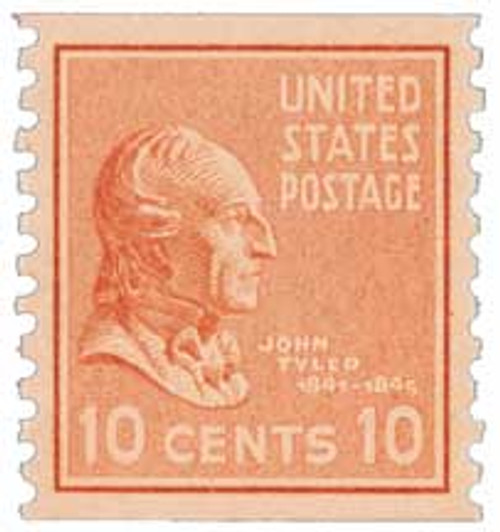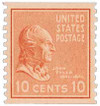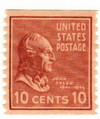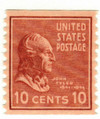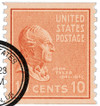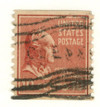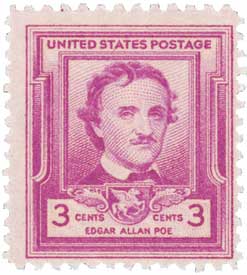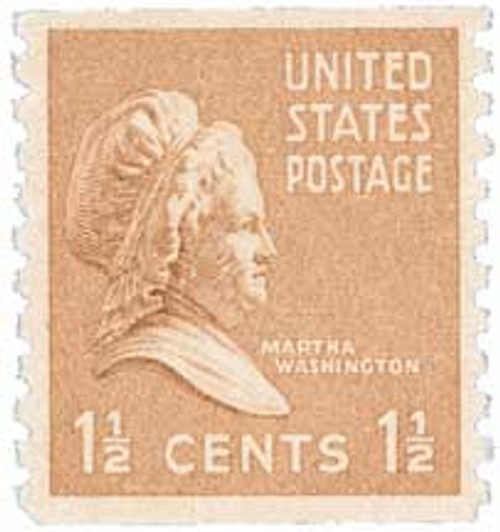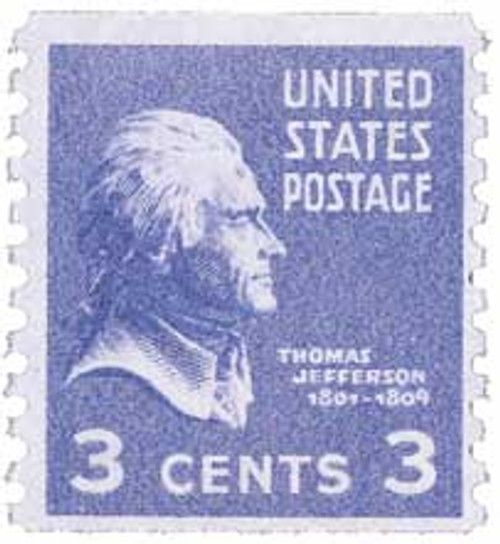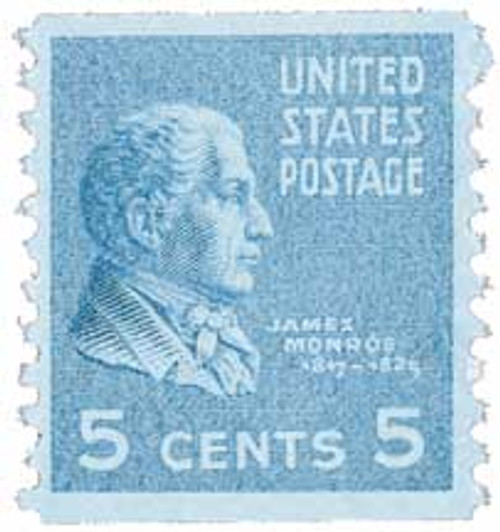
# 847 - 1939 10c John Tyler, brown red
10¢ Tyler
1939 Presidential Series
Rotary Coil
First City: Washington, D.C.
Quantity Issued: 22,065,500
Printed by: Bureau of Engraving and Printing
Printing Method: Rotary Press
Perforation: 10 vertically
Color: Brown red
Birth Of Renowned Writer Edgar Allan Poe
Poe’s work, featuring dark themes of death and violence, is a reflection of his tormented and tragic life. His father abandoned the family when Edgar was only a year old. His mother, actress Elizabeth Arnold Poe, died when he was only two. Eerily, the Richmond Theater, where she gave her last performance, burned to the ground a few days later, killing 72 people.
Orphaned at the age of two, Poe was taken in by John and Frances Allan, of Richmond, Virginia. They never formally adopted him, and Poe believed they never really loved him. His foster father both spoiled and sternly disciplined Poe throughout his childhood.
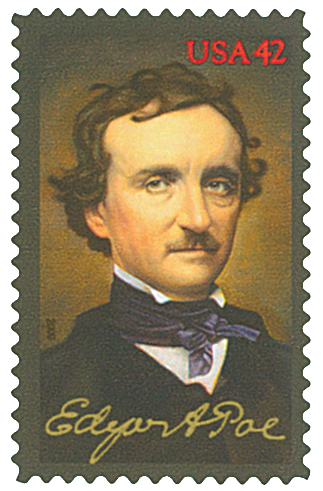
The family traveled to Britain in 1815, and Edgar attended grammar school in both Scotland and London. Poe returned to America in 1820 and later served in the youth honor guard that welcomed Marquis de Lafayette during his 1824 visit to America. In 1826 he attended the University of Virginia, but amassed significant gambling debts and dropped out after a year. Poe then took a series of odd jobs before enlisting in the Army.
Poe joined the Army for a five year term under the name Edgar A. Perry. He also lied about his age, claiming he was 22 when he was only 18. Around this same time, Poe published his first book, a 40-page collection of poetry titled, Tamerlane and Other Poems. There were only 50 copies printed and the book received little attention.
After a brief stint at Fort Independence in Boston, Poe was ordered to South Carolina’s Fort Moultrie in October 1827. Despite his poor performance in school, Poe was a good soldier, earning two promotions during his one-year stay at Fort Moultrie. He reached the highest rank of a non-commissioned officer, regimental sergeant-major.
Over the next few years, Poe worked for several other periodicals and attempted to start his own. On January 29, 1845, his poem “The Raven” was published in the Evening Mirror and earned him considerable fame. However, he was only paid $9 for its publication. Then in 1847, his wife who’d been sick for several years died. Poe’s drinking had worsened when she first became sick, but after her death he became unstable.
On October 3, 1849, Poe was found wandering the streets of Baltimore in a delirious state. He was taken to Washington Medical College where he died on October 7. His medical records and death certificate were lost, and no one knows for sure what caused his death. His last words were reported to have been “Lord help my poor soul.”
Click here to read some of Poe’s stories and poems.
10¢ Tyler
1939 Presidential Series
Rotary Coil
First City: Washington, D.C.
Quantity Issued: 22,065,500
Printed by: Bureau of Engraving and Printing
Printing Method: Rotary Press
Perforation: 10 vertically
Color: Brown red
Birth Of Renowned Writer Edgar Allan Poe
Poe’s work, featuring dark themes of death and violence, is a reflection of his tormented and tragic life. His father abandoned the family when Edgar was only a year old. His mother, actress Elizabeth Arnold Poe, died when he was only two. Eerily, the Richmond Theater, where she gave her last performance, burned to the ground a few days later, killing 72 people.
Orphaned at the age of two, Poe was taken in by John and Frances Allan, of Richmond, Virginia. They never formally adopted him, and Poe believed they never really loved him. His foster father both spoiled and sternly disciplined Poe throughout his childhood.

The family traveled to Britain in 1815, and Edgar attended grammar school in both Scotland and London. Poe returned to America in 1820 and later served in the youth honor guard that welcomed Marquis de Lafayette during his 1824 visit to America. In 1826 he attended the University of Virginia, but amassed significant gambling debts and dropped out after a year. Poe then took a series of odd jobs before enlisting in the Army.
Poe joined the Army for a five year term under the name Edgar A. Perry. He also lied about his age, claiming he was 22 when he was only 18. Around this same time, Poe published his first book, a 40-page collection of poetry titled, Tamerlane and Other Poems. There were only 50 copies printed and the book received little attention.
After a brief stint at Fort Independence in Boston, Poe was ordered to South Carolina’s Fort Moultrie in October 1827. Despite his poor performance in school, Poe was a good soldier, earning two promotions during his one-year stay at Fort Moultrie. He reached the highest rank of a non-commissioned officer, regimental sergeant-major.
Over the next few years, Poe worked for several other periodicals and attempted to start his own. On January 29, 1845, his poem “The Raven” was published in the Evening Mirror and earned him considerable fame. However, he was only paid $9 for its publication. Then in 1847, his wife who’d been sick for several years died. Poe’s drinking had worsened when she first became sick, but after her death he became unstable.
On October 3, 1849, Poe was found wandering the streets of Baltimore in a delirious state. He was taken to Washington Medical College where he died on October 7. His medical records and death certificate were lost, and no one knows for sure what caused his death. His last words were reported to have been “Lord help my poor soul.”
Click here to read some of Poe’s stories and poems.

